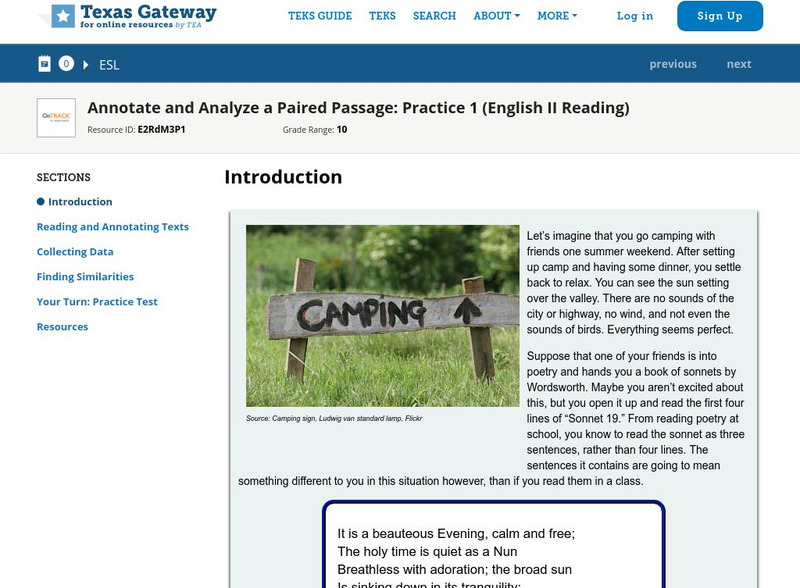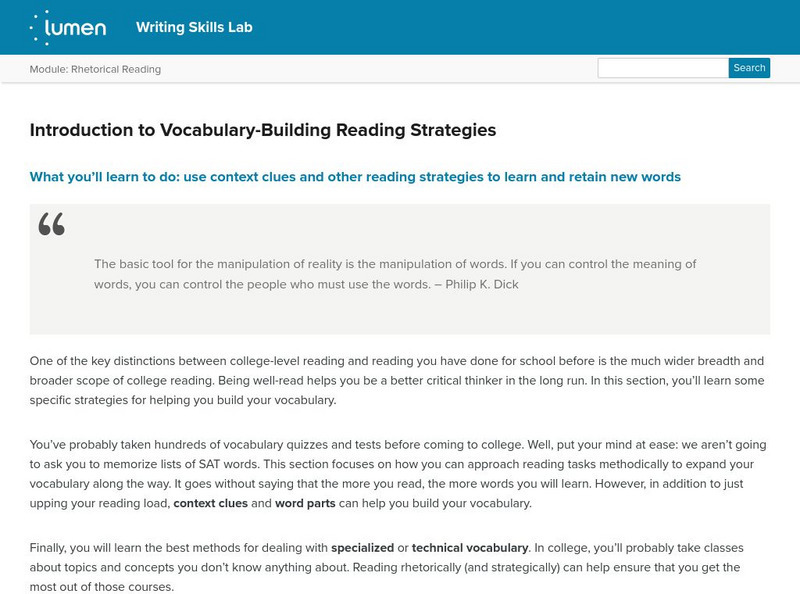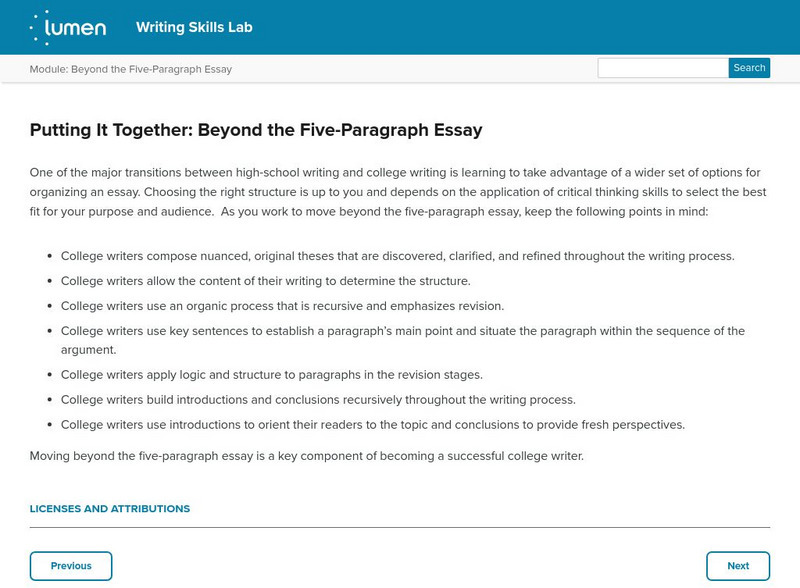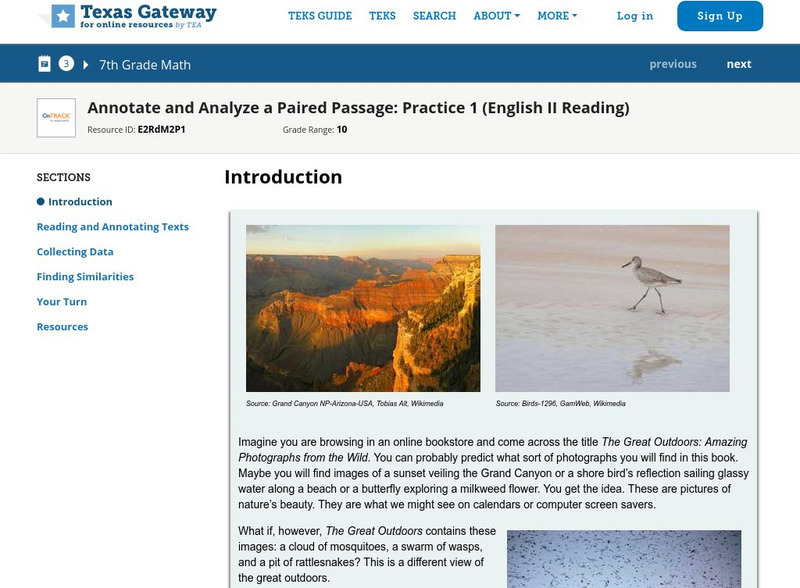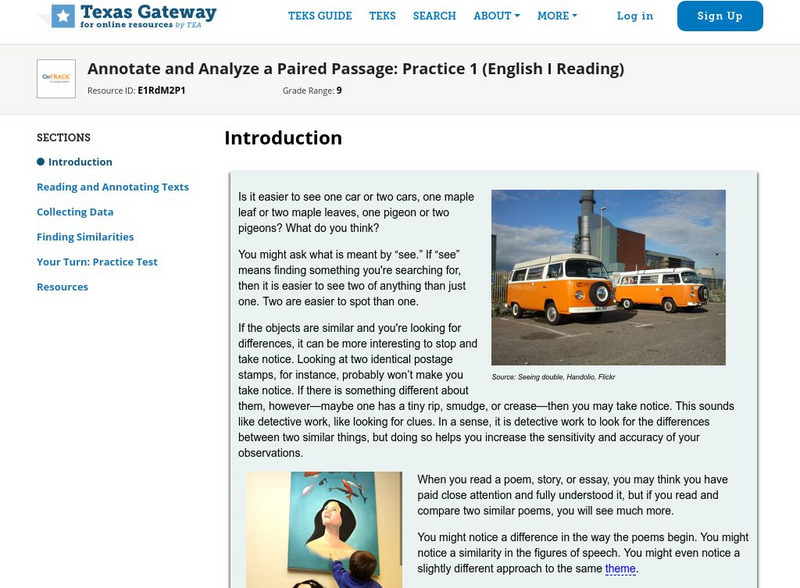CommonLit
Common Lit: Excerpt From "The Grasshopper"
A learning module that begins with Anton Chekhov's literary text "Excerpt from 'The Grasshopper'" accompanied by guided reading questions, assessment questions, and discussion questions. The text can be printed as a PDF or assigned...
CommonLit
Common Lit: Of Studies
A learning module that begins with "Of Studies" by Sir Francis Bacon, accompanied by guided reading questions, assessment questions, and discussion questions. The text can be printed as a PDF or assigned online through free teacher and...
CommonLit
Common Lit: The Kohlberg Dilemmas
A learning module that begins with "The Kohlberg Dilemmas" by Lawrence Kohlberg, accompanied by guided reading questions, assessment questions, and discussion questions. The text can be printed as a PDF or assigned online through free...
CommonLit
Common Lit: How Resilience Works
A learning module that begins with "How Resilience Works" by Diane Coutu, accompanied by guided reading questions, assessment questions, and discussion questions. The text can be printed as a PDF or assigned online through free teacher...
CommonLit
Common Lit: Ozymandias
A learning module that begins with "Ozymandias" by Percy Bysshe Shelley, accompanied by guided reading questions, assessment questions, and discussion questions. The text can be printed as a PDF or assigned online through free teacher...
Texas Education Agency
Texas Gateway: Annotate and Analyze a Paired Passage: Practice 1
Read and annotate paired texts in order to make inferences, draw conclusions, and synthesize ideas and details using textual evidence.
Texas Education Agency
Texas Gateway: Annotate for Meaning (English Ii Reading)
You will learn how to annotate or mark a text as you read and re-read to gain a deeper understanding of the text.
Texas Education Agency
Texas Gateway: Annotate and Analyze a Paired Passage: Practice 1
Read and annotate paired texts in order to make inferences, draw conclusions, and synthesize ideas and details using textual evidence.
Sophia Learning
Sophia: Summary and Paraphrase: Tutorial
In this slideshow tutorial, students are provided with notes that distinguish "summarizing" from "paraphrasing" content. Examples of effective summaries and paraphrases of text are provided. Then students have the opportunity to engage...
Lumen Learning
Lumen: Success Skills: Writing in College
Although this lesson focuses on college writing, it fits perfectly into the high school curriculum without being too difficult to understand. It provides types of essay writing assignments and how to handle each, strategies for writing...
Lumen Learning
Lumen: Rhetorical Reading: Intro to Vocabulary Building Reading Strategies
This article explains in general how to build vocabulary using reading strategies such as context clues.
Lumen Learning
Lumen: Putting It Together: Beyond the Five Paragraph Essay
This lesson focuses on strategies for moving essay writing beyond the five-paragraph essay structure to one whose structure is determined by the content. W.11-12.4 Clear/Coherent Writing
Lumen Learning
Lumen: Using Sources: Paraphrase and Summary
This lesson focuses on how to integrate source material using paraphrase and summary and the differences between the two. It also provides a practice exercise.
Lumen Learning
Lumen: Reading and Interpreting Literary Texts: How to Analyze a Short Story
This lesson focuses on analyzing a short story including all of the elements of a short story such as setting, plot and structure, and characterization.
Lumen Learning
Lumen: Examples of Multimodal Texts
This lesson focuses on providing examples of multimodal texts, those using more than one mode of communication in the same text.
Department of Defense
Do Dea: Real Survival Skills
Learn about process analysis, writing procedurals texts, the steps of the writing process, and cause and effect in this unit. Also, examine patterns of organization in writing. A handy chart shows common organizational patterns which...
Quizlet
Quizlet: Literary Elements Definitions
Learn about 32 different literary elements with flashcards, quizzes, and interactive games.
E Reading Worksheets
E Reading Worksheets: Text Structure Activities
Numerous links related to analyzing text structures are provided on this site. Lesson plans, PowerPoint slides, graphic organizers, rubrics, and quizzes related to text structures are also provided to support students while analyzing...
Pennsylvania State University
Pennsylvania State University (Dr. Mc Clennen): How to Do a Close Reading
This guide is written for college students, but should be very useful for upper level high school students as well. The writer first describes fourteen steps to take in doing a close reading, then provides six pieces of advice on how to...
International Literacy Association
Ila: Unlocking the Power of Informational Text With Five Creative Ideas
Five easy ways to help unlock the power of informational text for all students.
ReadWriteThink
Read Write Think: Unlocking Symbolism/themes in Drama
Online lesson which uses Hansberry's "Raisin in the Sun" to teach the concepts of symbolism and theme in a dramatic work. Students learn the importance and significance of these terms as they study this work and other works of drama....
Texas Education Agency
Texas Gateway: Informational Text: Analyze Graphical Sources: Practice 2
[Accessible by TX Educators. Free Registration/Login Required] In this lesson, you will learn how to evaluate the clarity and visual appeal of images and other graphic elements included in a reading text. Practice exercises are included.
Texas Education Agency
Texas Gateway: Annotate and Analyze a Paired Passage: Practice 1
In this lesson, you will read and annotate a pair of texts to make inferences, draw conclusions, and synthesize ideas and details using textual evidence. Prepare to get involved in a conversation between you and the two texts you will be...
Texas Education Agency
Texas Gateway: Annotate and Analyze a Paired Passage: Practice 1
In this lesson, you will read and annotate a pair of texts to make inferences, draw conclusions, and synthesize ideas and details using textual evidence. You are going to look at two texts together to better understand them.



